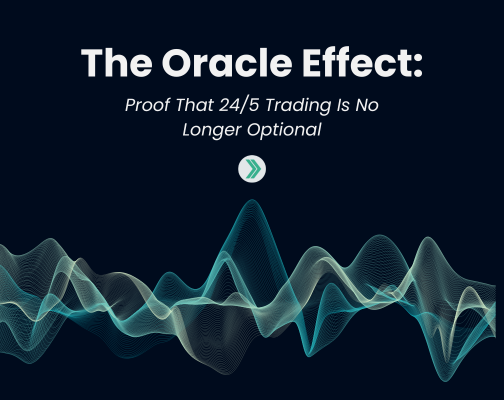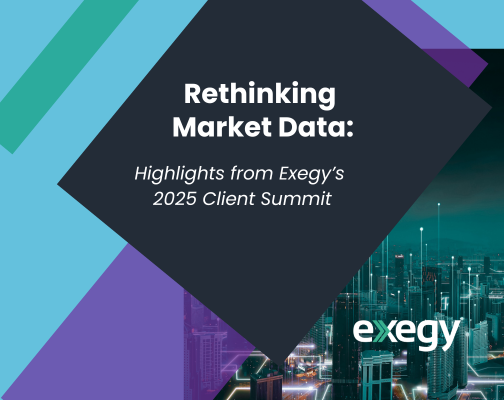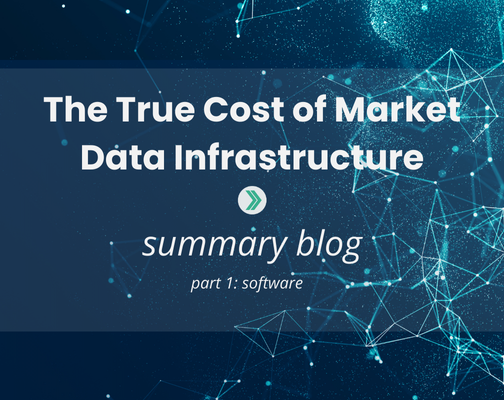The True Cost of Real-Time Market Data Infrastructure: Part II Summary
Field-programmable gate array (FPGA)-based market data processing delivers best-in-class performance for ultra-low latency trading environments. However, building and maintaining in-house FPGA feed handlers is unsustainable for many capital markets firms.
To help firms in visualizing the investment necessary to develop this infrastructure, Exegy composed a two-part series of research-backed white papers, The True Cost of Real-Time Market Data Infrastructure: Quantifying the Build vs. Buy Debate for Capital Markets Firms.
While Part I of the white paper series focuses on software feed handlers, offering a cost and resource analysis on building and maintaining market data processing technology in software, Part II (The Cost to Build and Maintain Market Data Processing Infrastructure Using FPGA Technology) analyzes FPGA-based market data infrastructure, quantifying the true costs and complexities of building in-house versus leveraging vendor solutions. The analysis combines real-world benchmarks from a Tier 1 global bank with Exegy’s two decades of experience in FPGA-based market data processing.
This blog summarizes the key findings of Part II, which illustrates that FPGA development is a distinct engineering discipline with inherent challenges, making vendor partnerships a more strategic and efficient choice for high-performance market data processing. The tradeoff isn’t just about speed—it’s also about cost, engineering complexity, and long time to market.
Market Dynamics Driving Adoption of FPGA Infrastructure
FPGA demand is experiencing substantial growth due to the increasing need for high-performance computing, AI, and other modern technology solutions. The market dynamics that primarily drive this demand include:
- Soaring market data volumes: The market has seen a 5x increase in derivatives since 2020 and a 57% increase in equities since 2019, outpacing infrastructure upgrades and thus increasing the risk of system failures.
- Infrastructure as a strategic edge: Latency and determinism are seen as differentiators for capital markets firms, offering participating firms an edge over competitors.
- Constraints on traditional scaling: Regulatory changes, such as tick size reduction and multi-leg order strategies, are amplifying bandwidth and message rate pressures, leading to space, power, and talent shortages.
- The choice to build versus buy infrastructure: Building in-house may initially seem like a way to retain control, but the true cost in time, resources, and ongoing maintenance is substantial.
When evaluating FPGA infrastructure, these pressures amplify the tradeoff, making the negative impact even more pronounced.
Benefits of Vendor Partnerships for High-Performance Market Data Processing
Regrettably, the operational realities of in-house FPGA development are frequently underestimated. For one, FPGA isn’t simply “faster software”—it requires a dual workflow (software logic → hardware implementation), leading to longer, sequential development cycles. Additionally, exchange-driven changes (EDCs) demand extensive development and quality assurance, such as full resynthesis and hardware regression testing, making updates slower and riskier compared to software-only systems.
FPGA feed handlers also don’t scale linearly—each new exchange adds nontrivial effort and cost. For example, each new market requires custom hardware parsing logic and testing. The cost of building an additional FPGA handler in-house is estimated at $261,290, compared to $100,000 through a trusted vendor.
The other primary ways that opting for vendor-managed FPGA market data infrastructure can benefit your firm include:
Lower In-House Costs
The report states that developing the first in-house FPGA feed handler costs $5.35 million—and that’s just for the initial feed handler. Scaling is also expensive; covering 18 North American markets totals $9.79 million, roughly five times more expensive than Exegy’s FPGA feed handler solution ($1.8 million annually). Each additional FPGA feed handler adds approximately $261,290 in development costs—more than double that of vendor-managed infrastructure.
Vendor-supported, ready-to-deploy FPGA feed handlers offer a faster, more cost-efficient solution for firms aiming to scale market data coverage without incurring substantial development overhead. Exegy provides FPGA feed handlers at $100,000 per market, totaling $2.2 million, including one-time hardware costs—a $7.6 million savings compared to full in-house development.
Faster Time to Market
In-house FPGA development requires long, often sequential software-to-hardware workflows. The report shows that building the first FPGA feed handler in-house takes 3.5 years, with each additional venue adding 8–12 months of development and testing. Achieving full North American coverage requires roughly 6.5 years, compared to around 20 months with Exegy’s FPGA feed handler solution—a 6x faster time-to-market.
Reduced Maintenance Costs
Lastly, FPGA maintenance requires a specialized, multidisciplinary team, which increases costs relative to software feed handlers. For reference, maintaining this type of market data infrastructure requires a 12-person multidisciplinary team (including hardware engineers, software engineers, QA, DevOps, and others)—far more resource-intensive than software systems. Annual maintenance costs range between $2.85 million and $4.59 million, depending on whether performance optimization is classified as maintenance or innovation.
Vendor-managed services minimize compliance risks, system outages, and maintenance overhead. This is because vendors such as Exegy absorb the burden of EDC resynthesis, regression testing, and latency optimization, reducing operational overhead. In the year 2023 alone, Exegy managed 8,356 exchange notifications and 481 EDCs, with 35% requiring code updates that demand extensive development and QA efforts.
Strategic Takeaways
Vendor-managed FPGA feed handlers deliver predictable costs and faster time to market, while reducing internal staffing burdens. Findings from Part II of the white paper conclude that, compared to Exegy’s managed solution, building FPGA market data infrastructure in-house is five times more expensive and six times slower to production.
Therefore, vendor-managed FPGA market data infrastructure is the most capital-efficient, scalable, and risk-optimized path forward for firms seeking ultralow-latency performance without compromising efficiency. Partnering with Exegy provides a faster, more cost-effective, and lower-risk approach to achieving market data infrastructure goals—empowering firms to innovate, scale, and compete more effectively.
Download the full white paper, Part II: The Cost to Build and Maintain Market Data Processing Infrastructure Using FPGA Technology, to explore the detailed cost models, benchmarks, and strategic insights.



